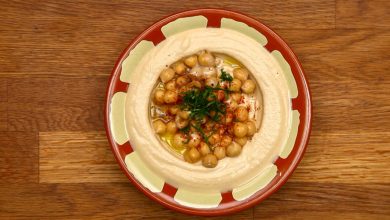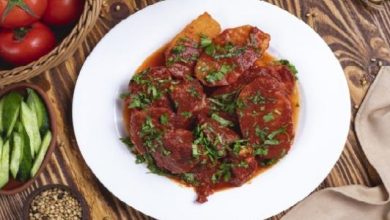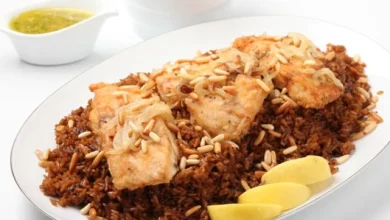Kouwaj, a popular dish across the Levant, particularly in Hama and other regions of Syria, is a delightful medley of vegetables such as potatoes, carrots, zucchini, eggplant, and onions mixed with tender meat chunks. This hearty meal is known for its rich flavor and numerous nutritional benefits. In this article, we provide two different recipes for making Kouwaj: the traditional stovetop method and the oven-baked version. Both methods capture the essence of this dish, bringing a taste of the Middle East to your table.
Time
- Preparation time: 30 minutes
- Cooking time: 1.5 to 2 hours
- Total time: Approximately 2.5 hours
Required Equipment
- Large cooking pot
- Large oven-safe dish (for the baked version)
- Wooden spoon or spatula
- Measuring spoons and cups
- Cutting board
- Knife
- Aluminum foil and parchment paper (for the baked version)
Tags
- Kouwaj Recipe
- Traditional Levantine Dishes
- Middle Eastern Cuisine
- Meat and Vegetable Stew
- Baked Casserole
- Syrian Recipes
Ingredients
Stovetop Kouwaj (Traditional Recipe)
| Ingredient | Quantity |
|---|---|
| Ghee or clarified butter | 1 tbsp |
| Onion, diced | 1 medium |
| Beef cubes | ½ kg |
| Tomato paste | 2 tbsp |
| Potato, diced | 1 large |
| Eggplant, diced | 1 medium |
| Zucchini, diced | 1 medium |
| Carrot, diced | 1 medium |
| Tomato, diced | 1 medium |
| Water | 1 liter |
| Salt | 1 tsp |
| Black pepper | 1 tsp |
| Mixed spices | 1 tsp |
Oven-Baked Kouwaj
| Ingredient | Quantity |
|---|---|
| Ghee or clarified butter | 1 tbsp |
| Onion, sliced | 2 medium |
| Green chili, sliced | 2 |
| Beef cubes | 2 cups |
| Potato, sliced | 1 kg |
| Eggplant, sliced | 2 large |
| Tomato, sliced | 1 kg |
| Tomato paste | 2 cups |
| Water | 2 cups |
| Salt | To taste |
| Black pepper | 1 tsp |
Instructions
Stovetop Kouwaj
- Sauté the onions and meat:
- In a large pot, heat the ghee over medium heat.
- Add the diced onions and sauté until they turn golden.
- Add the meat cubes and cook until the meat browns on all sides.
- Add the vegetables and tomato paste:
- Stir in the tomato paste, followed by the diced potatoes, eggplants, zucchini, carrots, and tomatoes.
- Mix well to combine all the ingredients.
- Season and simmer:
- Pour in the water and bring the mixture to a boil.
- Season with salt, black pepper, and mixed spices.
- Lower the heat, cover the pot, and let it simmer for 1.5 to 2 hours or until the meat is tender and the vegetables are fully cooked.
- Serve:
- Once the meat is tender, remove the pot from the heat.
- Serve the Kouwaj hot with your choice of side dish.
Oven-Baked Kouwaj
- Prepare the baking dish:
- Preheat the oven to 160°C (320°F).
- Grease the baking dish with ghee.
- Layer the vegetables and meat:
- Layer the onion slices at the bottom of the dish, followed by the green chili, beef cubes, potato slices, eggplant, and tomato slices.
- Continue layering the vegetables evenly until all ingredients are used.
- Mix the sauce:
- In a bowl, combine the tomato paste, water, salt, and black pepper.
- Pour this mixture evenly over the layered vegetables and meat.
- Cover and bake:
- Cover the dish with parchment paper first, then seal with aluminum foil to ensure it stays moist.
- Bake in the preheated oven for 1.5 to 2 hours or until the meat is fully cooked and the vegetables are tender.
- Serve:
- Remove from the oven and carefully uncover the dish.
- Serve hot as the main dish.
Nutritional Information
Stovetop Kouwaj (Per Serving)
| Nutrient | Amount |
|---|---|
| Calories | 320 kcal |
| Protein | 25 g |
| Carbohydrates | 20 g |
| Fat | 15 g |
| Fiber | 4 g |
| Sodium | 400 mg |
Oven-Baked Kouwaj (Per Serving)
| Nutrient | Amount |
|---|---|
| Calories | 350 kcal |
| Protein | 28 g |
| Carbohydrates | 25 g |
| Fat | 16 g |
| Fiber | 5 g |
| Sodium | 420 mg |
Tips and Tricks
- Tender meat: For the most tender meat, consider using beef with some marbling (fat content) and allow it to simmer for the full cooking time.
- Vegetable variations: Feel free to add or substitute other vegetables such as bell peppers, sweet potatoes, or mushrooms according to your preference.
- Spices: Experiment with spices like cumin, cinnamon, or allspice to enhance the flavor profile of the dish.
- Make it vegetarian: You can skip the meat and make a fully vegetarian Kouwaj by increasing the number of vegetables or adding plant-based protein like chickpeas.
Add-Ons
- Yogurt Sauce: A side of yogurt mixed with garlic and a touch of mint adds a refreshing contrast to the richness of the Kouwaj.
- Rice Pilaf: Serve the Kouwaj over a bed of fluffy rice pilaf seasoned with butter and pine nuts for a heartier meal.
Side Dishes
- Flatbread: Serve Kouwaj with warm flatbread for scooping up the flavorful stew and sauce.
- Pickled Vegetables: Middle Eastern pickled cucumbers or turnips provide a crunchy, tangy side to complement the dish.
Improvements
- Oven Roasting for Deeper Flavor: For a deeper, caramelized flavor, try roasting the vegetables before adding them to the stew.
- Slow Cooker Option: If you prefer, you can adapt the stovetop version of Kouwaj for a slow cooker. Simply sauté the onions and meat first, then transfer everything to a slow cooker and cook on low for 6-8 hours.
Save and Store
- Refrigeration: Leftover Kouwaj can be stored in an airtight container in the refrigerator for up to 3 days. Reheat gently on the stovetop or in the microwave.
- Freezing: You can freeze Kouwaj for up to 3 months. Allow it to cool completely before transferring to freezer-safe containers. Thaw overnight in the refrigerator before reheating.
FAQ
Can I use chicken instead of beef for Kouwaj?
Yes, chicken works well in Kouwaj. Use bone-in chicken pieces for more flavor and follow the same cooking instructions, but reduce the cooking time as chicken cooks faster than beef.
What can I substitute for ghee?
You can use olive oil or butter instead of ghee if you prefer. Ghee adds a traditional richness, but either alternative will work.
Can I prepare Kouwaj ahead of time?
Absolutely. You can prepare Kouwaj up to a day in advance and reheat it before serving. The flavors often deepen after sitting for a day.
What is the origin of Kouwaj?
Kouwaj originates from the Levant, specifically in Syrian and Palestinian cuisine. It is a traditional family dish enjoyed at gatherings and special occasions.
Can I add more spices to Kouwaj?
Yes, you can adjust the spices to your liking. Add cumin, coriander, or even a dash of cinnamon for a more complex flavor.
Conclusion
Kouwaj is a versatile and hearty dish that brings the authentic flavors of the Levant to your kitchen. Whether you opt for the traditional stovetop method or the baked version, you’ll enjoy the rich combination of tender meat and vegetables infused with aromatic spices. Pair it with rice or flatbread for a satisfying meal that is sure to impress.
References
- Middle Eastern Cooking Guide by Samira Kazan
- “The Flavors of Syria” by Amal Najjar
- “Authentic Middle Eastern Recipes” blog















